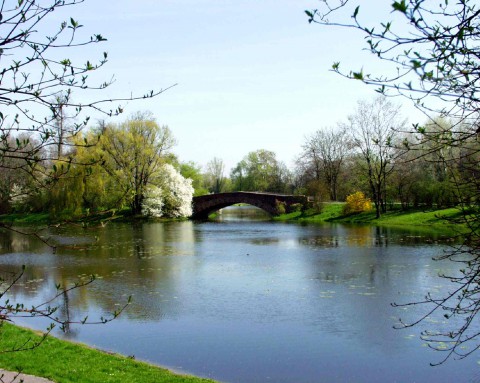The English Landscape Park
In 1799-1821, Stanisław Kostka Potocki and his wife Aleksandra have their Park extended to the north in a then-fashionable English style. The English Landscape Park was developed in stages as it called for substantial landscaping changes, including a dike and an island. New trees and shrubs had to be planted alongside Romantic architectural forms. The natural lake with its richly variegated shape was (and continues to be) an important element in the layout of the North Park. At the time, the Park was one of Europe’s largest water parks in Europe. All the buildings were linked by vista lines traced by alleys or gaps in tree groves to create impressive views extending far beyond the Park itself. Today, many of those original vista have become blurred: some vista lines have become overgrown, especially those east of the lake, where a natural reserve has been created in the Park Morysiński. But the Chinese Bower (built 1806-1812) still offers a splendid view of the island, the Roman Bridge and a lake cove.
At the lake’s bank there is a Pumping Room Building, designed by the Italian-born architect Enrico Marconi in the “Gothick” (pseudo-gothic) style to power the fountains in the Park.
North of the Pumping Room Building we reach a road leading to the island along an artificial dike. On the island there is a monument of the Battle of Raszyn (1809), built to commemorate Captain Ksawery Burski, who died in an attack on the Austrian military post in Wilanów.
suggested

Wilanów Residence
The Wilanów residence is composed of the palace, its decorations and works of art, gardens and sculptures located in the park and also numerous buildings and monuments raised in the location since 1677. A visit to Wilanów, be it virtual or real, provides an opportunity to experience the core of our tradition that is also a part of the common European culture.

Proprietors of the palace: from a king to a custodian
The Wilanów Palace, its beautiful gardens and buildings located in the park as well as the amassed works of art all constitute records of history. The venue commemorates Jan III, a warrior-king and at the same time a lover of books and paintings, a well-educated patron of art vividly interested in science. His memory was kept alive by Stanisław Kostka Potocki, an outstanding politician and founder of the Wilanów Museum.
















